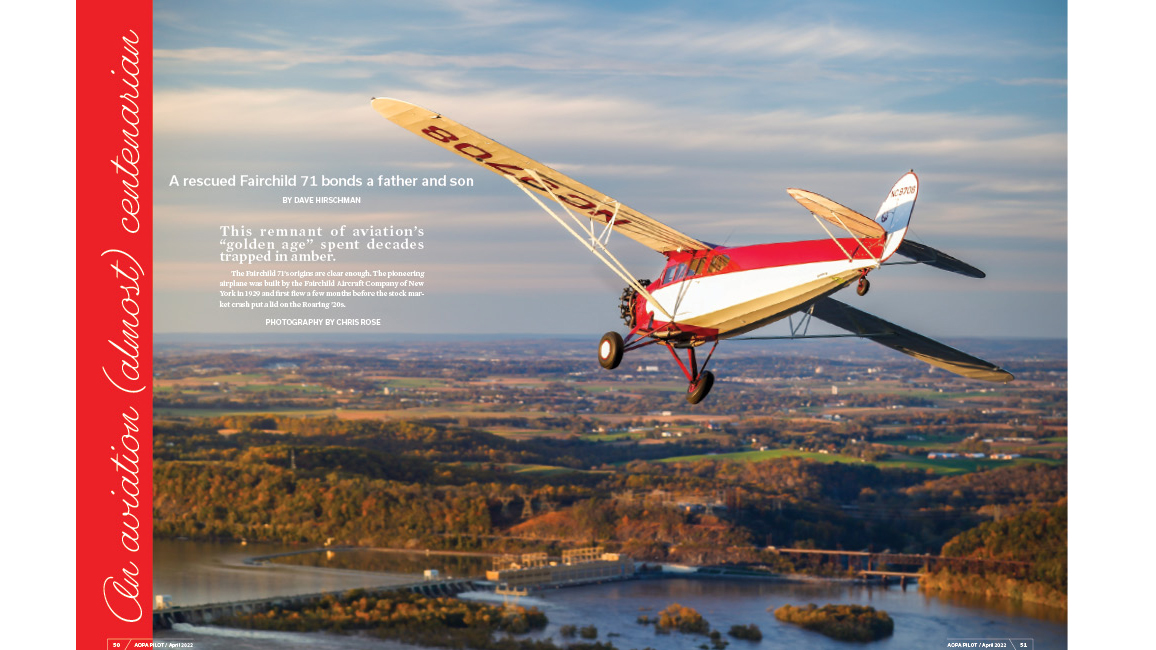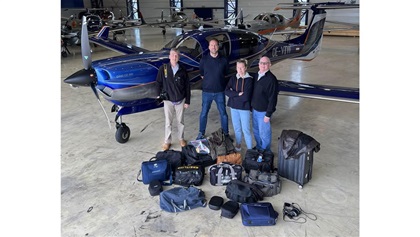Letters
Golden age pioneer

I read about the Fairchild 71 (“Golden Age Pioneer” April 2022 AOPA Pilot by Dave Hirschman) as I am a sucker for restoration stories. Much to my delight, a mention of Gene O. Frank in Idaho. I bought my Piper Cub from him many years ago. It was so much fun reading people’s description of the man and his collection. I had a very similar experience.
After two days on a Greyhound bus, I arrived in Caldwell, Idaho, early in the morning. I was wandering the streets waiting for a decent time before calling him to let him know I had arrived. A kind person stopped in a truck and asked if I needed a ride somewhere. I explained I was going to a strip outside of town but I would wait until it got later. “I know the place, hop in, I will give you a ride.”
Frank’s dog met me at the fence and woke up the caretaker living in a single-wide trailer. He was not happy to be woken up. He said he would call Gene, and I said, “No! I will just wait.” I didn’t want to start my visit out this way. It was too late. A short time later, a car drove up and the door swung open. Gene told me we were going to breakfast. I sat quietly while he ate his breakfast and visited with his morning coffee gang.
We eventually drove back to his place, and it was exactly as described. The Cub was sitting in a hangar full of Naval Aircraft Factory N3Ns covered in dust but complete, like the day they last flew, just all done and put away for years.
I spent a couple of days there. I got a tour of his place: the serial number one Super Cub that he was especially proud of; the Brunner-Winkle Bird that I had never heard of; and all the other amazing things tucked away in those buildings covered in dust.
I always wondered what became of him and his things. Ran in to him years later at the Watsonville fly-in where he was flying the Mylar-covered Jenny. He remembered me and was struggling to remember the N number of the Cub. He told me not to tell him. I waited a bit, then blurted it out, “N33112.” He yelled, “I told you not to tell me!” He was the same gruff guy I had met many years earlier.
Rowena Mason / AOPA 692253
Santa Paula, California
Not a joke
In 1929, a 7,200-mile nonstop flight took place. The was the first and only transcontinental and return flight with no stops in a single-engine aircraft utilizing aerial refueling (“Is This a Joke?” April 2022 AOPA Pilot). The pilot was Nicholas Bernard Mamer, a World War I fighter pilot, with co-pilot Art Walker, who was also a mechanic.
The 120-hour flight started August 15, 1929. It went from Spokane to San Francisco, then to New York and back to Spokane after 120 hours and 7,200 miles in a modified Buhl Airsedan, a single-engine 300-hp, six-passenger airplane. Preparations involved a number of airports, each with a tanker carrying up to four 50-gallon tanks of fuel flying 10 feet above the Airsedan. Gravity and hose were used, taking up to an hour to transfer the fuel, which was provided by sponsor Texaco. There were no radios or navigational aids, just a lot of ingenuity.
Frank Singer / AOPA 131549
Huntington Beach, California
Places to fly
What a great article (“Member Favorites: Your picks for best places to fly,” March 2022 AOPA Pilot) by Julie Summers Walker, with lots of fly-in destinations that I’ll add to my list. I was surprised by two omissions from the list that I believe will resonate with a number of pilots out west.
The first is Camarillo Airport (CMA) in Camarillo, California. A favorite activity for my wife and me is brunch at the Waypoint Cafe, where you can enjoy a terrific breakfast or lunch and watch the airport and ramp activity. They even have a small mockup of the airport for kids to play on before or after eating that includes a live broadcast of the control tower frequency and a 50-foot runway.
My other favorite is Harvey Field (S43) in Snohomish, Washington. A friendly, low-key airport with a great mix of GA and parachute operations on the field and, again, a great airport eatery to sit at and watch the activity. It’s the Buzz Inn Steakhouse, and the food is good, down-home, diner-style food. During a pleasant meal there, you can watch the jump plane load, take off, and then, 15 to 20 minutes later, witness the jumpers landing on the field. It’s hard not to enjoy a day out there.
Paul Downey / AOPA 843724
Carefree, Arizona
I’ve been going to Nu-Cavu at Kobelt Airport (N45) since before I owned an airplane, and the food and atmosphere is special enough that just about six years ago my wife and I got married there.
It is truly a fine Italian restaurant, well differentiated from the standard diner fare found at most airfields. Which is not meant to demean the $100 burger, but to mention that Nu-Cavu is exceptional.
Billy Richards, the owner, also owns Skydive the Ranch at Gardiner Airport (5NY5) a few miles north, where my wife and I have been skydivers for a decade. On Friday evenings Billy hosts a skydiving accuracy competition at Nu-Cavu, which is a crowd pleaser. It’s also something to be aware of, as there have been some close calls at Gardiner over the years. Best not to approach directly from the north.
Alexei Smirnov / AOPA 11178862
Weehawken, New Jersey
Aircraft for the mission
Thank you for including the Eclipse jet in your contest (“Aircraft For The Mission: The dream scenario,” May 2022 AOPA Pilot by Ian Twombly). For years now there has been so much bad information about the airplane and the company. I bought mine in 2013 and never regretted a single day.
The new company owners are doing a wonderful job, and there is not one part out of stock. Recently I flew from North Palm Beach County Airport, West Palm Beach, Florida (F45) to Republic Airport, Farmingdale, New York (FRG) in 2 hours and 36 minutes and used 1,100 pounds (165 gallons) of Jet A. I filed for FL370 even though my ceiling is FL410 and would have burned even less fuel higher.
Victor Girgenti / AOPA 5209379
Sands Point, New York
With a budget of $2 million, I would select the Twin Commander. Solid IFR platform and truly an amazing aircraft. This is a true “pilot’s airplane.”
Bill Morton / AOPA 268389
Vero Beach, Florida
I own an Eclipse 500 version 2.08 with fully integrated flight management systems. I had a Baron and was pretty happy when friends and I at 2018 AirVenture took a test ride in EA550. The Eclipse is arguably the smallest and least expensive entry point of twin jets, but this ship single-engine climbs over 1,000 feet per minute without much asymmetric thrust. After fighting the Baron low and slow single engine, I was sold.
I have four years in this aircraft now and it’s really a game changer in travel. Key is how well jets do cross-country compared to props. On one trip from Teterboro, New Jersey, to Hilton Head, South Carolina, I crossed several bands of a hurricane moving up the Atlantic coast, no turbulence at all. Headsets are not needed for passengers because the noise level is way less. Truly a better environment for passengers.
FL410, 350 knots, 1,000-mile range, IFR. Beats the pants off TBM and Twin Commander, and all for around $900,000. I do around 200 hours a year with an all-in cost of around $150,000. Doubt you could claim cost per mile same for the other two airframes.
Pete Muller / AOPA 1180120
Tucker, Georgia
I loved the feature “Is This a Joke?” in April 2022 AOPA Pilot by Julie Summers Walker. Here’s another aviation tidbit: In 1986, Dick Rutan and Jeana Yeager made a nine-day, around-the-world, unrefueled flight—the world’s first. Because they took off and landed at the same airport (Edwards Air Force Base in California), the flight could not be logged as cross-country under FAA rules.
Ed Fischer / AOPA 1386365
Philadelphia, Pennsylvania
We welcome your comments! Send letters to Editor, AOPA Pilot, 421 Aviation Way, Frederick, Maryland 21701 or [email protected]. Letters may be edited for length and style.



